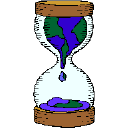|
Assignment 4 Adapted from: What On Earth Is Evolution? The Geological Perspective of Teaching Evolutionary Biology Effectively, by Abour Cherif, Jerry Adams, and John Loehr (2000) |
Goals:
Objectives: Students will be able to
|
|---|
|
In Assignment 3, we began exploring the age of the
Earth. You worked in small groups and as a class to complete the
"If Scientists Think. . ." table. Through presentation and
discussion of individual ideas, the class reached agreements as to the best way
to complete each of the prompts. Today's assignment will
allow you to compare and contrast your ideas to some of the actual methods
scientists used to develop an estimation of the age of the Earth.
Following this introduction, there are several links to different sites concerning the methods scientists use to assist them in estimating the age of the Earth. You will investigate Steno's Laws, radiometric dating, and then visit an interactive site that will help you better understand how to tell time - with geology! Because this assignment is linked with your work in Assignment 3, you will have "If Scientists Think. . ." returned to you. As you proceed through Assignment 4, be sure to compare your answers from "If Scientists Think. . ." to the actual methods scientists use to estimate the age of prehistoric objects. |
|
PART A. RELATIVE DATING: STENO'S LAWS Visit the following site and read about each of Steno's laws (principles). Keep these principles in mind as you progress through the rest of the activities in this assignment. It would benefit your understanding of this material if you studied the rest of this website on your own, but it is not required for class. Steno's Laws |
|
PART B. RADIOMETRIC DATING Continue to the Radiometric Dating portion of this assignment through use of a virtual web site. Answer the questions about each aspect of radiometric dating as you move through the various exercises of the Radiometric Dating Lab. If you have an incorrect answer be sure to figure out why that answer was wrong and what is the correct answer. This is a relatively long activity so stay focused on your work. Let your TA or Professor see your Certificate of Completion once you reach that screen at the end of the activity. |
|
PART C. GEOLOGIC TIME Understanding Geologic Time |


